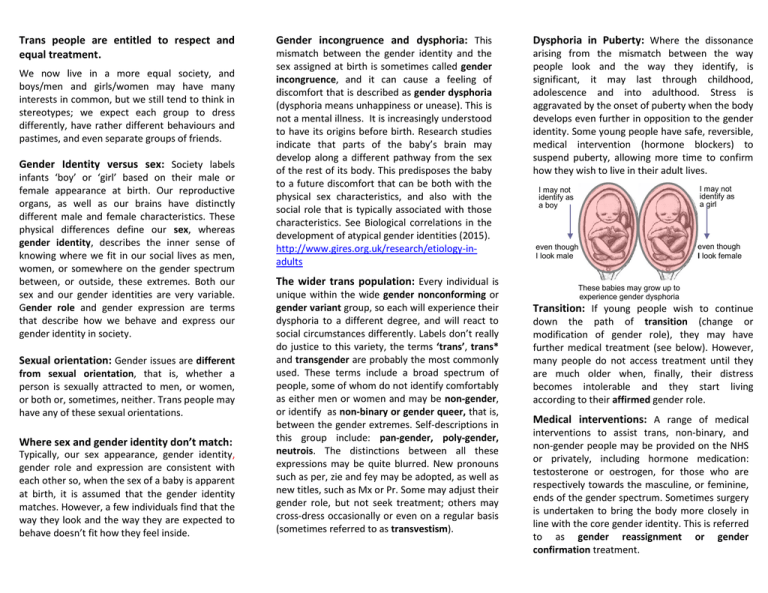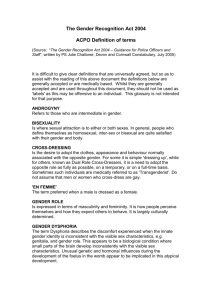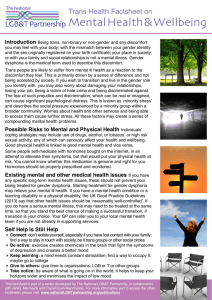Trans people are entitled to ... Gender incongruence and dysphoria: equal treatment.
advertisement

Trans people are entitled to respect and equal treatment. We now live in a more equal society, and boys/men and girls/women may have many interests in common, but we still tend to think in stereotypes; we expect each group to dress differently, have rather different behaviours and pastimes, and even separate groups of friends. Gender Identity versus sex: Society labels infants ‘boy’ or ‘girl’ based on their male or female appearance at birth. Our reproductive organs, as well as our brains have distinctly different male and female characteristics. These physical differences define our sex, whereas gender identity, describes the inner sense of knowing where we fit in our social lives as men, women, or somewhere on the gender spectrum between, or outside, these extremes. Both our sex and our gender identities are very variable. Gender role and gender expression are terms that describe how we behave and express our gender identity in society. Sexual orientation: Gender issues are different from sexual orientation, that is, whether a person is sexually attracted to men, or women, or both or, sometimes, neither. Trans people may have any of these sexual orientations. Where sex and gender identity don’t match: Typically, our sex appearance, gender identity, gender role and expression are consistent with each other so, when the sex of a baby is apparent at birth, it is assumed that the gender identity matches. However, a few individuals find that the way they look and the way they are expected to behave doesn’t fit how they feel inside. Gender incongruence and dysphoria: This Dysphoria in Puberty: Where the dissonance mismatch between the gender identity and the sex assigned at birth is sometimes called gender incongruence, and it can cause a feeling of discomfort that is described as gender dysphoria (dysphoria means unhappiness or unease). This is not a mental illness. It is increasingly understood to have its origins before birth. Research studies indicate that parts of the baby’s brain may develop along a different pathway from the sex of the rest of its body. This predisposes the baby to a future discomfort that can be both with the physical sex characteristics, and also with the social role that is typically associated with those characteristics. See Biological correlations in the development of atypical gender identities (2015). http://www.gires.org.uk/research/etiology-inadults arising from the mismatch between the way people look and the way they identify, is significant, it may last through childhood, adolescence and into adulthood. Stress is aggravated by the onset of puberty when the body develops even further in opposition to the gender identity. Some young people have safe, reversible, medical intervention (hormone blockers) to suspend puberty, allowing more time to confirm how they wish to live in their adult lives. The wider trans population: Every individual is unique within the wide gender nonconforming or gender variant group, so each will experience their dysphoria to a different degree, and will react to social circumstances differently. Labels don’t really do justice to this variety, the terms ‘trans’, trans* and transgender are probably the most commonly used. These terms include a broad spectrum of people, some of whom do not identify comfortably as either men or women and may be non-gender, or identify as non-binary or gender queer, that is, between the gender extremes. Self-descriptions in this group include: pan-gender, poly-gender, neutrois. The distinctions between all these expressions may be quite blurred. New pronouns such as per, zie and fey may be adopted, as well as new titles, such as Mx or Pr. Some may adjust their gender role, but not seek treatment; others may cross-dress occasionally or even on a regular basis (sometimes referred to as transvestism). I may not identify as a girl I may not identify as a boy even though I look male even though I look female These babies may grow up to experience gender dysphoria Transition: If young people wish to continue down the path of transition (change or modification of gender role), they may have further medical treatment (see below). However, many people do not access treatment until they are much older when, finally, their distress becomes intolerable and they start living according to their affirmed gender role. Medical interventions: A range of medical interventions to assist trans, non-binary, and non-gender people may be provided on the NHS or privately, including hormone medication: testosterone or oestrogen, for those who are respectively towards the masculine, or feminine, ends of the gender spectrum. Sometimes surgery is undertaken to bring the body more closely in line with the core gender identity. This is referred to as gender reassignment or gender confirmation treatment. Successful outcomes: These social and physical Equality changes are very successful in giving trans and non-binary people a sense of authenticity. Some undertaking this process may prefer to be described as trans men (assigned female at birth, identifying as men or towards the masculine end of the gender spectrum) or trans women (assigned male at birth but identifying as women or towards the feminine end of the gender spectrum). However, once they are living in the new gender role, many prefer to lose the ‘trans’ label altogether. Having established a sense of harmony, they are better able to make a valuable contribution to society, in all walks of life. ‘Gender reassignment’ is a ‘protected characteristic’ under the Equality Act 2010, making it unlawful to discriminate against, harass or victimise trans people, in education, employment, in the provision of goods and services and in their private lives, from the moment they reveal that they are intending to undergo a process of reassignment, or ‘a part of [that] process’. This protection also applies to those who are perceived to be trans, or who are associated with them, e.g. a partner, relative or carer. Dignity and privacy is also protected under the Human Rights Act 1998. At the point of transition, families and significant others, as well as trans people themselves, are vulnerable to unfair treatment, and may experience great stress and feel isolated and fearful. Respect: It is paramount that trans people are treated with respect and do not experience discrimination in clinical and other settings. Medical professionals should use names, titles and provide hospital accommodation that the individuals concerned regard as appropriate. This will usually be consistent with their dress and presentation. If unsure, medical staff should discuss this with the individual, privately. Confidentiality in health and social care settings: Confidentiality is an especially sensitive issue for trans individuals. A few will have the added privacy protection of a Gender Recognition Certificate, but even without this it is good practice to ensure that no unnecessary disclosure of their trans status or history occurs. This applies whether the treatment is specifically for gender dysphoria, or for any medical condition. Trans people require the usual range of medical procedures from flu’ jabs to heart surgery. and Human Rights legislation: Information and Support for trans, non-binary and nongender people also for their families, employers and service providers The law requires employers and service providers to respect trans people’s new names, titles and pronouns; their trans history should not be revealed; access to toilet and changing facilities must be in accordance with their permanent gender expression. All existing and new policies must be scrutinised to avoid any unintended disadvantage to trans people. Social inclusion must be facilitated. FOR INFORMATION AND SUPPORT (2015) TranzWiki lists 257 groups nationwide www.tranzwiki.net elearning resources: for professionals and families caring for gender nonconforming young people: www.nlmscontent.nesc.nhs.uk/sabp/gv For employers and service providers: http://www.gires.org.uk/elearning/new/player.ht ml For GPs: http://elearning.rcgp.org.uk/gendervariance www.gires.org.uk © Gender Identity Research and Education Society Registered Charity 1068137 info@gires.org.uk Tel: 01372 801554 GIRES, Melverley, The Warren, Ashtead, Surrey, KT 21 2SP





